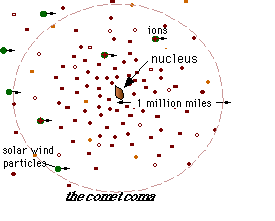This is a drawing of what the surface of a comet might look like.
Click on image for full size
JPL
The Comet Nucleus
The nucleus of a comet is the central portion of the head of a comet. It is a solid part of the comet,
made of a special sort of dust which is called "fluffy" because it could be as light weight and full of holes as a sponge. The holes of this "sponge" are filled with ices like water, carbon dioxide (dry ice), and carbon monoxide (what comes out of your car).
Observations of the nuclei of comet Hale-Bopp and Hyakutake have given scientists fresh ideas about comet composition and evolution.
But, scientists still don't know whether the nucleus is very hard, like solid ground, or very soft and breakable, like a snowball. The Rosetta mission hopes to land a probe on the surface of a comet to find out just how hard it is!
As a comet approaches the Sun, it begins to evaporate, forming the coma and a spectacular comet tail.
This picture shows that evaporation may happen only in specific places on the nucleus. These spots of evaporation are called "jets". Halley's comet had three distinct jets on its surface as it approached the Sun in 1986.
You might also be interested in:

This example of Interstellar Dust is a perfect example of the kind of rocky material that may make comets. The grains themselves seem to be made of smaller grains. There are many holes, or pores. In a
...more
Hale-Bopp continues to offer new surprises as two astronomers report of their study of the comet. Using the Hubble Space Telescope and the International Ultraviolet Explorer, the astronomers did a year-long
...more
When comets are kicked out of the Oort Cloud, they begin a passage into the solar system, spinning and tumbling as they come. The trajectory which they acquire can be hyperbolic, parabolic, or elliptic
...more
As the ices of the comet nucleus evaporate, they expand rapidly into a large cloud around the central part of the comet. This cloud, called the coma, is the atmosphere of the comet and can extend for millions
...more
The picture on this page shows the best views ever of the nucleus of a comet. It shows two pictures of the comet's nucleus that were taken at slightly different times. The pictures were taken by a spacecraft
...more
NASA’s Comet Nucleus Tour (CONTOUR), launched July 3, 2002. The CONTOUR spacecraft will fly by at least two comets, taking pictures and collecting dust from the nucleus of each comet to help scientists
...more
We are sad to report that the Comet Nucleus Tour (CONTOUR) is currently lost in space. The CONTOUR spacecraft was launched July 3, 2002 to explore the nucleus of comets. It was scheduled to fly by at
...more














